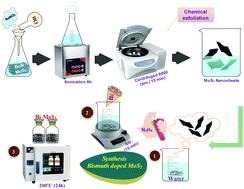当前位置:
X-MOL 学术
›
Dalton Trans.
›
论文详情
Our official English website, www.x-mol.net, welcomes your
feedback! (Note: you will need to create a separate account there.)
Synergistic effect of Bi-doped exfoliated MoS2 nanosheets on their bactericidal and dye degradation potential.
Dalton Transactions ( IF 3.5 ) Pub Date : 2020-04-28 , DOI: 10.1039/d0dt00924e U Qumar 1 , M Ikram 2 , M Imran 3 , A Haider 4 , A Ul-Hamid 5 , J Haider 6 , K N Riaz 7 , S Ali 8
Dalton Transactions ( IF 3.5 ) Pub Date : 2020-04-28 , DOI: 10.1039/d0dt00924e U Qumar 1 , M Ikram 2 , M Imran 3 , A Haider 4 , A Ul-Hamid 5 , J Haider 6 , K N Riaz 7 , S Ali 8
Affiliation

|
Nanosheets incorporated with biological reducing agents are widely used to minimize the toxic effects of chemicals. Biologically amalgamated metal oxide nanomaterials have crucial importance in nanotechnology. In this study, bare and bismuth (Bi)-doped molybdenum disulfide (MoS2) nanosheets were synthesized via a hydrothermal method. Different Bi weight ratios of 2.5, 5, 7.5 and 10% were incorporated in a fixed amount of MoS2 to evaluate its catalytic and antimicrobial activities. Doped nanosheets were characterized using XRD, FTIR and UV-vis spectroscopy, FESEM, HRTEM, Raman, PL, DSC/TGA, EDX, XRF and XPS analysis. The XRD spectra confirmed that the doped nanosheets exhibit a hexagonal structure and their crystallite size increases gradually upon doping. The morphology and interlayer d-spacing of doped MoS2 were determined by FESEM and HRTEM. The presence of functional groups in the doped nanosheets was confirmed using FTIR, PL and Raman analysis. The absorption intensity increased and the corresponding measured band gap energy decreased with doping. The thermal stability and weight loss behaviour of the prepared samples were studied using DSC/TGA. The doped MoS2 nanosheets showed a higher catalytic potential compared to undoped MoS2. The doped Bi nanosheets exhibited higher antimicrobial activity against Gram-positive Staphylococcus aureus (S. aureus) and Gram-negative Escherichia coli (E. coli) at different concentrations of Bi (0.075 and 0.1), showing a tendency to counter the emerging drug resistance against pathogenic bacterial diseases. Consequently, significant inhibition zones were recorded against (MDR) S. aureus ranging from 2.25 to 3.3 mm and 3.25 to 5.05 mm at low and high concentrations of doped-Bi nanosheets and against Gram-negative E. coli ranging from 1 to 1.45 mm at high concentrations. In conclusion, the Bi-doped MoS2 nanocomposite has exhibited significant potential for use in industrial dye degradation applications. Its antibacterial properties can also mitigate health risks associated with the presence of several well-known pathogens in the environment.
中文翻译:

Bi掺杂的MoS2剥落纳米片对它们的杀菌和染料降解潜力具有协同作用。
掺有生物还原剂的纳米片被广泛用于使化学品的毒性作用最小化。生物融合的金属氧化物纳米材料在纳米技术中至关重要。在这项研究中,通过水热法合成了裸露和掺铋(Bi)的二硫化钼(MoS2)纳米片。将2.5、5、7.5和10%的不同Bi重量比掺入固定量的MoS2中,以评估其催化活性和抗菌活性。使用XRD,FTIR和紫外可见光谱,FESEM,HRTEM,拉曼,PL,DSC / TGA,EDX,XRF和XPS分析对掺杂的纳米片进行表征。XRD光谱证实,掺杂的纳米片表现出六边形结构,并且其微晶尺寸在掺杂时逐渐增加。通过FESEM和HRTEM确定了掺杂的MoS2的形貌和层间d间距。使用FTIR,PL和拉曼分析证实了掺杂的纳米片中官能团的存在。随着掺杂,吸收强度增加并且相应的测量带隙能量减小。使用DSC / TGA研究了所制备样品的热稳定性和失重行为。与未掺杂的MoS2相比,掺杂的MoS2纳米片表现出更高的催化潜力。掺杂的Bi纳米片在不同的Bi浓度(0.075和0.1)下对革兰氏阳性金黄色葡萄球菌(S. aureus)和革兰氏阴性大肠杆菌(E. coli)表现出更高的抗菌活性,显示出对抗新出现的耐药性的趋势抵抗致病性细菌疾病。因此,记录了针对(MDR)金黄色葡萄球菌的显着抑制区,范围为2.25至3.3 mm和3.25至5。在低浓度和高浓度的Bi-Bi纳米片中为05毫米,对革兰氏阴性大肠杆菌的浓度为1到1.45毫米。总之,Bi掺杂的MoS2纳米复合材料在工业染料降解应用中显示出巨大的潜力。它的抗菌特性还可以减轻与环境中几种知名病原体的存在相关的健康风险。
更新日期:2020-03-30
中文翻译:

Bi掺杂的MoS2剥落纳米片对它们的杀菌和染料降解潜力具有协同作用。
掺有生物还原剂的纳米片被广泛用于使化学品的毒性作用最小化。生物融合的金属氧化物纳米材料在纳米技术中至关重要。在这项研究中,通过水热法合成了裸露和掺铋(Bi)的二硫化钼(MoS2)纳米片。将2.5、5、7.5和10%的不同Bi重量比掺入固定量的MoS2中,以评估其催化活性和抗菌活性。使用XRD,FTIR和紫外可见光谱,FESEM,HRTEM,拉曼,PL,DSC / TGA,EDX,XRF和XPS分析对掺杂的纳米片进行表征。XRD光谱证实,掺杂的纳米片表现出六边形结构,并且其微晶尺寸在掺杂时逐渐增加。通过FESEM和HRTEM确定了掺杂的MoS2的形貌和层间d间距。使用FTIR,PL和拉曼分析证实了掺杂的纳米片中官能团的存在。随着掺杂,吸收强度增加并且相应的测量带隙能量减小。使用DSC / TGA研究了所制备样品的热稳定性和失重行为。与未掺杂的MoS2相比,掺杂的MoS2纳米片表现出更高的催化潜力。掺杂的Bi纳米片在不同的Bi浓度(0.075和0.1)下对革兰氏阳性金黄色葡萄球菌(S. aureus)和革兰氏阴性大肠杆菌(E. coli)表现出更高的抗菌活性,显示出对抗新出现的耐药性的趋势抵抗致病性细菌疾病。因此,记录了针对(MDR)金黄色葡萄球菌的显着抑制区,范围为2.25至3.3 mm和3.25至5。在低浓度和高浓度的Bi-Bi纳米片中为05毫米,对革兰氏阴性大肠杆菌的浓度为1到1.45毫米。总之,Bi掺杂的MoS2纳米复合材料在工业染料降解应用中显示出巨大的潜力。它的抗菌特性还可以减轻与环境中几种知名病原体的存在相关的健康风险。











































 京公网安备 11010802027423号
京公网安备 11010802027423号